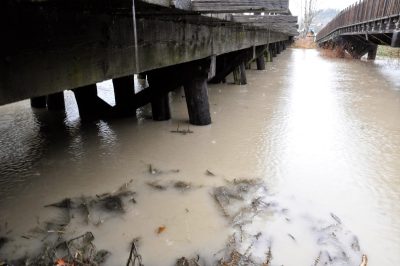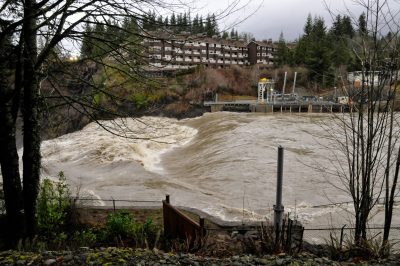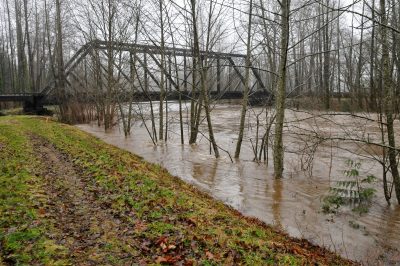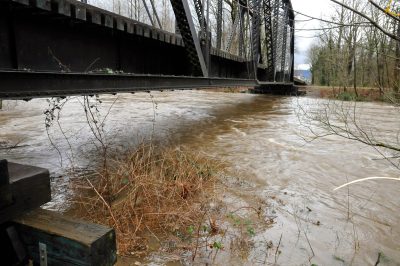
Bridge 32 in downtown Snoqualmie is quickly engulfed in water. Normally, Kimball Creek is 18 inches deep and about ten feet wide.
The Northwest Railway Museum is located in the urban flood plain. That really isn’t something the Museum has any choice about because it is built on and around a 19th Century railroad, and most mountain railroads are either along the river or on a hillside. Last Monday, January 5, 2015, heavy rain combined with melting snow to create a rapidly rising river that crested at one of the highest flow rates ever recorded. Fortunately, the Museum avoided any significant damage.

The Salish Lodge and Spa keeps watch over an angry river as it plunges over the top of Snoqualmie Falls.
The Seattle, Lake Shore and Eastern Railway arrived in Snoqualmie in 1889 (the Museum commemorated the 125th anniversary of passenger service to Snoqualmie Falls with a special train on July 4th, 2014) and the civil engineer – Charles Baker – that designed the line chose the best possible grade and location. Interestingly, the Snoqualmie Depot in downtown Snoqualmie is the highest point in downtown (it is unlikely that was by accident) as was much of the line, but encroaching development has brought structures and significant changes in surface water management. So now some of the railroad grade is susceptible to flood damage because adjacent development constricts water flow and generates scouring velocities that have in the past removed vast quantities of railroad ballast from under the track.
Several projects in the last ten years have reduced flooding impacts. First, a flood reduction project by the Army Corp of Engineers widened the river at Snoqualmie Falls to increase capacity of the river. Second, Puget Sound Energy’s rehabilitation of the Snoqualmie Falls hydro electric development removed the permanent weir (dam) across the river, but also other obstructions that were close to the river’s edge including the remains of Bridge 5.46.
Last Monday’s flood was the first major event since completion of all the construction projects. Naturally, when water flow rates approached those of prior major events including 2011 and 1996, many thought the Museum would sustain damage. Fortunately, they were wrong.
The floor reduction projects appear to have made a difference. Despite more than 51,000 cubic feet per second (normally it is about 2,000) of water flow over Snoqualmie Falls, there was no water over the track. There was some minor scouring around bridge 35 in North Bend, but no damage that requires repair at this time.
The flood reduction work that has spared the Museum damage during this recent event is not without controversy. Spike cannot attest to the downstream impact in Fall City, Carnation and Duvall, which is a matter of considerable debate and has generated at least one lawsuit. However, conditions for Snoqualmie and the Museum have improved dramatically, and bode well for the overall improved sustainability of the community.



